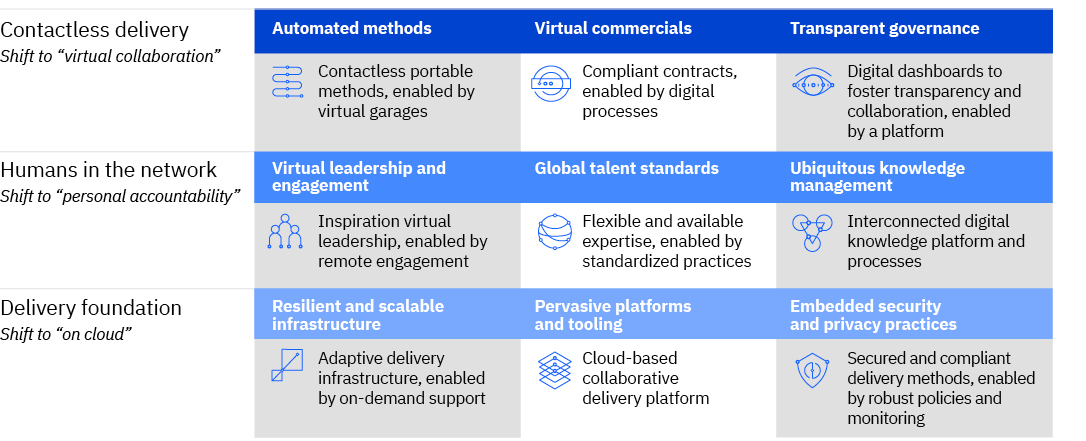COVID-19 disruption has provided a unique opportunity for many companies to accelerate their journey to Cognitive Enterprise and hybrid multicloud.
As the impact of COVID-19 reverberated throughout the world, transformation journeys were disrupted, and organizations reacted by moving their employees to shelter-at-home while continuing critical business operations. They also updated workplace policies, deployed virtual employee engagement processes and quickly embraced collaboration platforms to effectively execute work virtually. In this evolving world, the physical barriers of an office have been removed with the shift to distributed, self-empowered teams in a virtually equidistant world.
However, as organizations adjust to the new normal, the need for accelerating Digital Reinvention® and cloud adoption has become a crucial lever for growth.
Our perspective on Digital Reinvention envisions a Cognitive Enterprise™ powered by intelligent workflows, underpinned by hybrid multicloud. However, navigating the journey in the uncharted waters of remote, contactless work requires a resilient delivery model designed for both virtual and physical work patterns.
We have evolved and strengthened our services delivery model to help our clients address the new requirements and continue to drive sustained value. We call this holistic model “Dynamic Delivery.” It integrates technical foundations and humans in the network with virtualized methods, enhanced with AI and automation, to support rapid adaptation to changing business conditions. As the report says, it goes beyond just virtual collaboration or automating select processes. It represents the next generation of service delivery necessary to help businesses realize value in the new normal.
According to our recently released report on the new delivery model: “Fundamental to Dynamic Delivery is the focus on motivating and empowering employees, inspirational virtual leadership, flexible and available expertise, and interconnected digital knowledge platforms and processes.” Companies that deploy Dynamic Delivery can improve timeline confidence, orchestrate and optimize talent, reduce costs, and continue to accelerate their digital transformation journey to become Cognitive Enterprises.
Dynamic Delivery comprises three key components, each with three key groups of capabilities (see figure below):
- Delivery foundation: Fulfils the technical requirements necessary for a flexible service delivery model.
- Humans in the network: Provides the roadmap for building and managing virtual teams, developing and deploying new engagement methods, enhancing leadership models and enabling cloud-based knowledge management.
- Contactless delivery: Uses the necessary methods and tools framework enabled by extreme automation and seamless virtual collaboration.
These components and capabilities are based on insights we gained from virtualizing our own operations across the globe and successfully delivering multiple client engagements since the onset of the pandemic.

While we continue to support our clients during the pandemic, the phrase “we won’t be unprepared again” echoes repeatedly. Whether you try to do it on your own, or engage with experienced service providers, there are some actions you can take to be better prepared for the future.
To get started, we recommend initiating the following actions on each of the nine components shown in the figure above:
- Perform a gap assessment. Examine your work practices to determine which are best suited to virtual delivery and which require co-location. This gap assessment should serve as a starting point in your delivery transformation.
- Develop standards. Review your infrastructure—including your network, tools, IT support, and virtual office configurations—to enable virtual working.
- Redesign, build a roadmap and deploy. Establish polices, processes, tools, enablement, and governance across the nine components.
- Create strong governance and measurement systems. Install digital dashboards, enabled by a platform to foster transparency and collaboration. This is critical to pervasive adoption and buy-in of the Dynamic Delivery model in your organization.
As you consider transforming delivery in your organization, we encourage you to address the following questions:
- Are you establishing new capabilities for remote interaction and engagement with your customers and vendors?
- Are your infrastructure, policies, and IT support processes enabled for scalable and compliant delivery from offices and non-traditional locations?
- Do you have a delivery platform for seamless operations across locations, and is your platform scalable and interoperable for deployment across partners?
- Are your security practices adequate and embedded in the new ways of working?
- Are your processes for employee acquisition, onboarding, development, assessment and engagement reimagined with a mix of virtual and in-person?
- How are you executing capacity management and deployment processes for virtual delivery?
- Have you institutionalized your knowledge management tools and processes to enable seamless virtual delivery?
- Are your work practices and methods automated and enabled for virtual delivery in case of disruption?
- To what extent is your process for contracting with partners and vendors digitized and are your vendor management processes virtualized?
- How have you enabled your governance for virtual execution, for example, a digital dashboard?
To learn more, read our new report on Dynamic Delivery.
Meet the author



